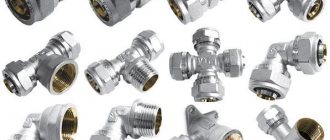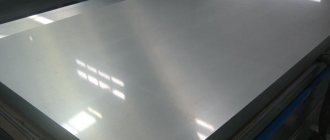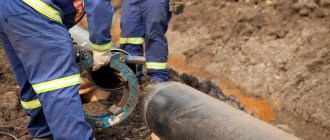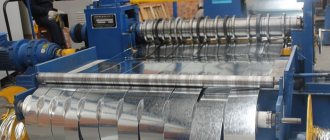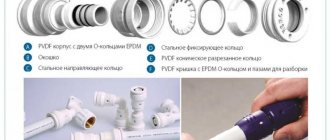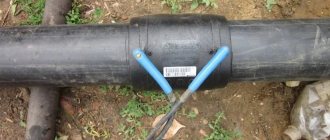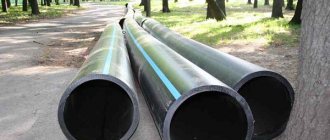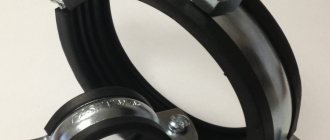In wooden houses, as well as in buildings in which flammable materials were used in the construction or decoration, experts recommend installing electrical wiring in pipes.
However, this technology is also applicable when repairing brick and concrete buildings, so studying it will be useful for craftsmen in any case.
When laying in thick floors, care must be taken to protect
The use of plastic pipes for electrical wiring
HDPE pipes for electrical wiring are considered a new generation of materials that have a number of undeniable advantages compared to metal pipes.
HDPE pipes for cable have the following advantages:
- high resistance to corrosion and chemicals;
- long service life (up to 50 years);
- low weight, making such pipes easy to transport and lay;
- there is no need for additional wire protection;
- moisture that gets inside the pipe will not begin to destroy it from the inside;
- small cross-section pipes bend easily;
- relatively low cost of material;
- you can assemble a ready-made system without having any special knowledge or skills for this type of work.
Smooth PVC electrical pipes are made by continuous extrusion and are characterized by low linear expansion, rigidity and stability. Such pipes are ideal for laying electrical wiring in concrete structures. There are PVC pipes with sections of 16-50 mm, although their length does not exceed 3 meters.
Smooth pipes are designed to protect the cable from mechanical damage. They can be laid as open wiring on the ceiling made of low- and non-flammable materials. There are many types of PVC pipes: rigid, smooth, reinforced and corrugated. And they all differ in their own characteristics, which will be relevant in each individual case. For example, pipes with smooth walls are used for laying and protecting wires in the walls of residential buildings, as well as administrative and industrial structures. Their main goal is to obtain an extremely reliable electrical wiring system.
Smooth single-wall HDPE pipes are suitable for pouring concrete, as well as for laying them in brick walls. They are connected using special tees, couplings, bends, and so on.
Positive qualities of such pipes:
- service life of at least 50 years;
- are not afraid of low temperatures;
- the cross-section of the pipes does not change during the entire service life, no deposits accumulate on the internal walls, and moisture does not collect on the external walls;
- excellent smooth pipe surface that does not need to be treated or covered with paint;
- do not pose a danger to the environment, plus they are very easy and safe to work with;
- light weight and reasonable price.
Rules for installation work
When laying wiring in a metal hose, it is necessary to take measures to ground it.
At the stage of installing pipes for electrical wiring, it is important to observe the following rules:
- The work should be carried out in 2 stages. First, the beginning and end of the pipes that are connected to the distribution panel, control apparatus, and electrical receiver are schematically depicted. Next, calculate suitable mounting points, bending angles, and locations for mounting the boxes.
- During installation, the metal conductors of the wiring must be grounded using a flexible copper jumper leading from the housing to the pipe. As an alternative, ground nuts can be used.
- Before tightening the pipe, it is important to blow it out and then level it.
- You should always leave a reserve in the boxes for connection in case of emergency situations. Making connections in pipes is strictly prohibited. The resistance between the pipe and the wires is at least 0.5 Mohm.
Installation should be carried out in such a way that, if necessary, the wiring can be removed without much effort. Connections are made using couplings and fittings.
The difference between cables and wires depending on the core material
Cores of wires and cables for specialized purposes can be made of various metals, but aluminum and copper are mainly used in electrical engineering. Each of them has its own specific properties, advantages and disadvantages, which must be taken into account when selecting a core material for a specific purpose.
Aluminum conductors
The invention of a relatively inexpensive method for extracting aluminum made a revolution in the global development of electrification, because in terms of electrical conductivity this metal ranks fourth, behind only silver, copper and gold. This made it possible to reduce the cost of production of wires and cables as much as possible and make universal electrification a reality.
Such electrical wires and their types are distinguished by their low cost, chemical resistance, high level of heat transfer and low weight - they have determined the mass of electrification in industrial and domestic conditions for more than half a century.
In light of the relatively recent dominance of aluminum in the wire market, it may seem strange to the uninitiated that the provisions of the PUE prohibit the use of this material in everyday life. More precisely, you cannot use aluminum wires with a cross-section of less than 16 mm², and these are the most common of them for installing home electrical wiring. To understand why there is a ban on the use of these wires, you can familiarize yourself with their advantages and disadvantages.
+ Advantages of aluminum wires
- Lighter than copper.
- Significantly cheaper.
— Disadvantages of aluminum wires
- Aluminum conductors with a cross-section of up to 16 mm² can only be single-wire, which means they can only be used for laying stationary wiring and without bending at an acute angle. All flexible wires and cables have always been made of copper.
- The chemical resistance of aluminum is determined by the oxide film that forms when it comes into contact with air. Over time, with constant heating of the contact due to the flow of electric current through it, this film deteriorates electrical conductivity, the contact overheats and fails. That is, aluminum wires require additional maintenance, and the contacts through which powerful currents pass are coated with a special lubricant.
- Amorphous material - if you clamp two aluminum wires together, the contact will weaken over time, as the aluminum will partially “leak out” from under pressure.
- Soldering can only be carried out using special tools, and welding can be performed in a chamber with an inert gas.
- Good electrical conductivity is observed only in pure aluminum, and impurities inevitably remaining during production worsen this indicator.
As a result, aluminum is a good choice if you need to save money here and now, but in the long run its use will be more expensive due to its relatively short service life and the need for regular maintenance. For this reason and additional safety reasons, the PUE strictly prohibits using it for laying new power lines.
Copper conductors
In terms of electrical conductivity, copper is in second place, only 5% inferior to silver in this indicator.
Compared to aluminum, copper has only 2 significant disadvantages, due to which for a long time it was used much less frequently. Otherwise, copper wins in all respects.
+ Pros of copper wires
- Electrical conductivity is 1.7 times higher than aluminum - a smaller cross-section of wire will pass the same amount of current.
- High flexibility and elasticity - even single-core wires can withstand a large number of deformations, and multi-core wires make cords for electrical appliances with increased flexibility.
- Soldering, tinning and welding are carried out without the use of additional materials.
— Disadvantages of copper wires
- The cost is several times more expensive than aluminum.
- High density - a coil of copper wire, the same length and cross-section as aluminum, will weigh 3 times more.
- Copper wires and contacts oxidize in open air. However, this practically does not affect the contact resistance and, if necessary, is “treated” by lubricating the surface of the already tightened contact.
As a result, although copper is a more expensive material, in general its use is more economical, since it is more durable, requires less effort during installation and attention during maintenance.
What does grounding protect against?
Thanks to grounding, you can protect your household from electric shock when touching the pipes. The effect of electric current is manifested as follows:
| 0.6 – 1.5 thousand µA | A person feels the effect of electric current in his body. |
| 2 – 4 thousand µA | The fingers begin to tremble, the person cannot stop it. |
| 5 – 7 thousand µA | Brushes relieve cramps. |
| 10 – 15 thousand µA | Without the help of others, a person cannot independently unclench the fingers of the hand in which the conductor is located. |
| 20 – 25 thousand µA | Breathing is difficult, you cannot free yourself from the influence of the conductor, and severe pain appears. |
| 50 – 80 thousand µA | Disturbances in the functioning of the heart, paralysis of the respiratory system occurs. |
The range of metal pipes for electrical wiring is quite extensive; in order to purchase the most suitable option, you need to familiarize yourself with the design features, its advantages and disadvantages.
Selection of metal pipes for cable laying
The electric cable can be laid in almost any pipes.
The minimum requirement for the casing is the absence of rust, burrs and internal irregularities.
Metal pipes are selected according to various parameters: price, decorativeness
Pay attention to the resistance of pipes against corrosion, as well as how easy it is to install the system
- The most decorative are copper and brass pipes; they cope better than others with the task of decorating electrical wiring laid in an open way and do not require painting. At the same time, thin-walled pipes allow the casing to be given any necessary shape without the use of shaped elements, while thick-walled pipes can further emphasize the deliberate roughness of the communication by assembling the pipeline using fittings.
- Stainless steel pipes are the most expensive, but reliable and easy to install: they do not need to be painted, they are smooth inside and out, do not corrode and are suitable for laying cables in any way.
- Galvanized ones have the same advantages as stainless steel ones, but their price is lower, so galvanizing is often preferred. However, the service life of galvanized pipes is half as long.
- Steel pipes that do not have a protective coating and aluminum pipes will need to be painted inside and out before installation to prevent oxidation. If an electrical cable in a steel casing is laid in a cement screed, the outer surface of the pipe does not need to be painted.
- Corrugated pipes are easy to install as they easily take on the required shape. Their disadvantage is a weak level of cable protection from compression and impact, so corrugation should not be used for underground communications and in rooms where the risk of strong physical impact is high.
In construction stores you can choose consumables for laying electrical cables to suit every taste. But pipes remaining after the dismantling of a gas or water supply system are also suitable.
It is important to first inspect the future casing and assess its condition: if the pipes do not have cracks, internal seams or other irregularities, they can be used. If the pipe does not have a protective coating, it must be painted. Painting is done from the inside by pulling a sponge with paint or pouring paint into a vertical pipe
Painting is done from the inside by pulling a sponge with paint or pouring paint into a vertical pipe
If the pipe does not have a protective coating, it must be painted. Painting from the inside is done by pulling a sponge with paint or pouring paint into a vertically located pipe.
Conclusion
Installation of electrical wiring in steel pipes, as well as the use of corrugated casings made of technopolymers for arranging communications, allows us to solve a wide range of problems. Using this technique, we will not only protect conductors from mechanical damage and the walls of the structure from possible fire, but will also make our life much easier when repairing or modifying wiring.
The video in this article will help you learn the basics of installing such systems, so beginners should study it especially carefully.
Did you like the article? Subscribe to our Yandex.Zen channel
Why water pipes are not suitable for cable
You may have repeatedly seen how cable laying (for example, to the distribution panel of a private cottage) is carried out in the ground using pipes for process water. So, this is far from the best solution.
Polyethylene pipes for process water are not advisable from the point of view of safety and economy
The truth is that water pipes, if they are without water, burn very quickly (when they are used as expected, with water, then, of course, they do not burn). Immediately a solid argument “against”. In principle, it is possible to lay cables in water pipes, but only if the entire structure is buried underground. In this case, there is no oxygen, which means there is no danger of combustion.
What about mechanical protection? There is also a big question here. Electrical cable pipes are designed to withstand external pressure in the form of compression. But water pipes maintain the pressure of water from the inside, so they are made to be resistant to pressure - this is a completely different specificity and, accordingly, design.
It should also be noted that this method is economically inappropriate. The fact is that the cost of pressure water pipes is higher than electrical installation ones.
In general, water pipes are not used for wiring because:
- they are more expensive
- they are flammable.
But if you have an extra ten meters of water supply, you can bury it with a cable to the nearest outbuilding on your summer cottage. But the electrical installation is still an order of magnitude better for laying in the ground, because it is strengthened precisely from the process of squeezing from the outside.
Don't need such a dubious compromise? Then you will have to choose from the originally intended options to lay the cable in the pipes.
Laying sequence
Preparatory work
So, all materials have been purchased, installation can begin. And here it’s worth starting with making a plan.
Optimal wall markings in terms of labor costs
To begin with, we apply markings on the walls along which the installation will be carried out.
In this case, you should adhere to a number of rules:
- Firstly, the fewer turns the route contains, the easier it will be to replace conductors if necessary.
- Secondly, sections with two or more pipe bends should be made no longer than 5 meters - for the same reasons.
- The maximum rotation angle is 900. If you make sharper bends, almost any cable will get stuck when you try to pull it through.
Advice! Only thin-walled metal and corrugated casings should be bent. It is better to connect thick-walled steel and plastic pipes using fittings, making sure that burrs do not form on the inside, which can cause damage to the insulation.
- So that during repairs we do not have to look for wires every time by drilling several holes in the walls, it is better to lay all horizontal sections at the same level. Or it’s even easier to do it by laying them deep in the floor.
- It is also advisable to place the cable channels at a distance from the heating pipes, otherwise the wiring in the copper pipe and cables in thin-walled steel or brass tubes will heat up.
Wall chipping
Having drawn the main lines on the surfaces and marking the installation locations of switches/sockets, we get to work.
In the case of a wooden building, the labor intensity will be small (you can simply hide the casings under the cladding), but in brick or concrete walls you will have to cut grooves:
- First, we make recesses for installing distribution boxes, sockets and switches. They must be of sufficient size to mount these parts flush with the wall surface.
Working with a wall chaser
Note! The instructions prohibit hiding the covers of distribution blocks under plaster or sheathing.
- Then, using a hammer drill with a chisel or a special wall chaser, we form channels in the walls for laying pipes.
- At the last stage, we drill holes through which communications will pass from one room to another.
Advice! When working with a hammer drill or wall chaser, it is necessary to comply with safety and labor protection regulations. So the presence of plastic glasses and a respirator to protect against dust is mandatory, and noise-isolating headphones will not be superfluous.
- When laying cables deep into the floor on joists, we provide grooves in the supporting structures, in which pipes with conductors will then be laid.
- When choosing the placement of such grooves, we make sure that the elements are not exposed to excessive pressure, i.e. we place them below the floor level by at least 10-15 mm.
Casings inserted into holes in joists
Equipment installation
After this, we proceed to install all the parts of our electrical network:
- First, we install the distribution boxes. It is advisable to take metal ones, but in some cases cheaper plastic ones are sufficient - as long as their size allows all the wire connections to be placed inside.
- In the same way, we install socket boxes and plastic “cups” for installing switches.
Photos of installed socket boxes
Advice! In all of these devices, you must first remove the covers from the special holes for inserting the wires.
Next we move on to laying the pipes themselves. As we noted above, different materials can be used, but they must provide sufficient mechanical protection and heat resistance. For example, for steel pipes, the wall thickness should be selected in accordance with the following requirements:
| Wire cross-section, mm2 | Wall thickness, mm | |
| Copper | Aluminum | |
| 2.5 or less | 4 or less | any |
| – | 6 | 2,5 |
| 6 | 10 | 2,8 |
| 6-10 | 16-25 | 3,2 |
| 16 | 35-50 | 3,5 |
| 25-35 | 70 | 4 |
When laying pipes, two technologies can be used:
- In the first case, a so-called broach is inserted into the casing - a polymer cord or thin steel wire with high elasticity. With the help of these elements we will be able to pull the conductors we need into the pipe.
Pulling with wire attached
- In the second case, we immediately lay the wire into the pipe, leaving a small margin for connection in the junction box.
Both methods are quite easy to implement with your own hands, so the choice is largely determined by your personal preferences, as well as your specific work situation. However, the first method is still preferable, especially if we plan to install several wires of different sections.
- We lay pipes with installed broaches or cables in grooves or place them between the sheathing beams.
- We fix all the parts using either clamps on the anchors (for brick and concrete structures) or special metal clips (for wood).
- We connect the ends of the pipes to the distribution boxes, as well as to the socket boxes and bases for switches.
Plastic pipes with broaches
Advice! If the wiring is installed in a damp room, then all joints and connections should be sealed to prevent moisture from entering and short circuiting the wires.
- We lay a separate pipe for connection to the panel and meter.
Laying and connection
The most labor-intensive part of the work ends here.
However, we should not relax - we have to insert the wires and casings as carefully as possible and make the connection:
- Using broaches, we lay the cables in the pipes, leading the ends into distribution boxes and socket boxes.
- If necessary, we connect the conductors using twists or (which is both safer and more convenient) special terminal blocks. We carefully isolate all connection points.
Note! Connecting two wires inside a pipe is strictly prohibited. All contacts must be organized only in areas to which there is access.
Connection via terminal block
- We connect the removed wires to the terminals of switches and sockets.
- After completing the work, we check the insulation resistance. This is done in order to find out whether its integrity was compromised during installation of the system.
If metal elements were used when forming the channels, then to ensure electrical safety in the event of an insulation breakdown, it is also worth connecting a grounding circuit.
Types of clips for fastening wires
When installing open wiring, attaching a wire or cable to the ceiling or wall can be done in various ways. One of the frequently used installation options is based on the use of special fasteners - clips.
Depending on what kind of conductor needs to be laid, whether it is fastened in a pipe, a corrugated sleeve, or openly, whether there are requirements for the appearance of the wiring, clips for wires and cables are used, having different designs and sizes.
Below is an overview of these mounting products.
Clips for mounting corrugated or PVC pipes
In the case when a cable or wire is laid in a corrugated or PVC pipe, it is convenient to use elastic plastic clamps - latches, shown in the photo:
They are made by plastic injection molding and are equipped with stiffening ribs that ensure grip strength on the pipe or corrugation. The use of high-quality plastic allows the product to maintain mechanical characteristics over a wide range of operating temperatures.
Fastening is done with a self-tapping screw. The size range is represented by clips with installation diameters from 12 mm to 50 mm.
A special feature of this product is special grooves on the side surfaces of the clip, thanks to which clips of different sizes can be combined into blocks when parallel laying of several cable lines is necessary.
You should begin work by carefully marking the wiring route. Clips or blocks of them must be attached at equal distances.
If several lines are laid in parallel and the clamps are combined into blocks, there is no need to attach each of them to the wall; it is enough to secure one of the three or four connected clamps.
Depending on the material of the wall or ceiling, the clamp can be attached either by directly screwing in a screw (for wood or drywall) or into a pre-drilled hole (for metal or plastic).
For installation during installation of a cable clamp on brick or concrete, it is better to use a dowel-nail of the required size. The installation ends by installing the pipe into the latch and lightly pressing until it enters the groove, accompanied by a click. We described in more detail how to route the cable through the corrugation in a separate article.
The photo below shows a version of a clamp that secures sealed pipes or corrugations. It is equipped with a clasp that provides a tighter fit. This clamp, like the previous one, is installed under a screw.
Application of thin-walled pipes
A few words about the specifics of products of this type. Since we are talking about technical products, its definition should contain numbers, and not a subjective assessment of belonging to one class or another. So: the range of thin-walled steel pipes includes products with a wall thickness of no more than 1.5 millimeters or if the value of the coefficient determined by the formula
Din. is the outer diameter, and S st. – wall thickness, lies in the range of 12.5...40.
A good example of the use of thin-walled metal products includes pneumatic and hydraulic drive systems in the automotive, aviation and shipbuilding industries.
Of course, the above-mentioned area of application for thin-walled steel pipes is far from the only one. They can be found in such industries as:
- construction;
- housing and communal services sector;
- furniture manufacturing;
- boiler houses of energy enterprises.
Architectural elements or decorative items can be made from steel pipes
In everyday life, these products are also not uncommon. But here they are most often used when engineering communications must have moderate strength, sufficient to withstand only low loads. In this case, we are talking primarily about a thin-walled steel pipe for electrical wiring.
Corrugated pipes
On sale you can even find varieties of such pipes with very large sections that are laid in concrete or cement screed.
Recommended pipe sizes for various purposes are:
- for installation of switches and sockets – 20 mm;
- for installation of lighting elements – 16 mm;
- laying a line between the boxes and distribution panels - 25 mm;
- for making connections between floors – 40 mm.
Let us note the most significant advantages of corrugated pipes for home use:
- electrical wiring will be reliably protected from mechanical damage;
- possibility of quick installation without additional elements;
- non-flammability of the material - thanks to this, the risk of fire of wires is eliminated;
- high-quality insulation of electrical wires;
- the flexibility of the pipe allows you to create a line of any configuration, passing along the shortest path.
Regulatory documents
Characteristics of copper decorative pipe and additional elements for electrical wiring
The technology of electrical installation work is regulated by a unified set of building codes and regulations, which are mandatory for any organization, production or department.
The following provisions serve as regulatory documents:
- PUE (edition No. 7) - rules for the design of electrical installations for new and reconstructed buildings with equipment operating at voltages up to 500 kW.
- SNiP (2.08.01–89, 2.09.04–87) – regulations that prescribe general provisions, design standards, installation and work acceptance rules.
- PTB (153–34.0–03.150) – safety rules when carrying out electrical installation and debugging work.
The production of steel electrical pipes is regulated by GOST No. 10704–91, 10706–76 and the international standard CEI EN No. 50086–1. GOST contains a complete list of characteristics and technical requirements for the product.
The technical and operational characteristics of rigid smooth PVC pipes are regulated by the interstate standard adopted in 2014 - GOST 32126.1–2013. The old GOST 50827–95 is no longer valid.
Advantages and disadvantages of laying in the soil
Advantages of laying power lines in the soil:
- The soil serves to a certain extent as mechanical protection of communications - when laid underground, hurricanes, ice, snow, wind, and the movement of large vehicles are not afraid.
- Sometimes overhead installation is simply impossible - if there is a highway or geological obstacles in the way).
- Neither ill-wishers nor thieves will damage communications; will not be chewed by rodents and will not be damaged by a cluster of sitting birds.
- In the event of a break or short circuit, the earth serves as a grounding conductor - this reduces to a minimum the fire of wiring in the house, the contact of voltage on the building structures and engineering systems (this will protect a person in the event of an accident from injury from electric shock).
- Invisible communications do not spoil the design of the site. This is especially true when distributing lighting around the site or the entrance to the site.
Flaws:
- Excavation work increases the cost of laying communications, requires time, labor and certain efforts to restore the soil surface - the excavated soil will settle for several years. If the mound is leveled, then in a couple of years a groove will appear in place of the trench.
- Laying in pipes is more difficult and more expensive than hanging a cable through the air.
- Pipeline installation also complicates the work.
- When turning communications, you will have to equip a well.
- The most unpleasant thing is that if a cable is damaged, replacing it is quite complicated, takes time, and sometimes is simply impossible (for example, when the soil freezes to a significant depth, it is impossible to dig a trench manually, and digging with an excavator on the site means damaging plantings, sites, possibly a fence or buildings).
Why are wires laid in pipes?
According to PUE 2.2.20 (Rules for the construction of electrical installations), conductors subject to mechanical stress must be additionally protected. In addition, the gasket in the pipe provides the following protection:
- from stretching, squeezing, breaking, puncture;
- protects a flammable base or a fire-hazardous room from fire during a short circuit (short circuit);
- prevents sunlight and precipitation from destroying the insulation.
This method is used mainly in industrial premises and when laying in soil.
Materials for the manufacture of tubes for electrical wiring
The choice of material from which the channel is made depends on the type and characteristics of the room where the wiring is planned.
Pipes can be made from:
- plastic;
- copper;
- brass;
- become.
In the manufacture of plastic products, polyvinyl chloride (PVC), high-pressure (HP) and low-pressure (LP) polyethylene (D) are used. Products made from polyvinyl chloride are in high demand among consumers because they have an affordable price and are characterized by good strength and resistance to high temperatures. The most common PVC pipes have a diameter of 16 to 60 millimeters.
Plastic products have a smooth inner surface, and this feature makes it easier to carry out work related to replacing conductors. They are also lightweight and resistant to corrosion. In addition, channels made of polyethylene and polyvinyl chloride are dielectrics and therefore can be considered an additional insulating circuit.
Brass or copper thin-walled tubes are suitable for installation on wall surfaces and for concealed wiring. Such products bend easily and do not require decorative design.
Plastic or metal? - that is the question
The choice depends on what kind of wiring and under what conditions you plan to carry out. And it also requires relying on the standards prescribed in the PUE. But these are general words, so I’ll go straight to the specifics.
Metal pipes are practically not used in electrical installations
And this is the first thing you need to know. Pipes made of stainless or galvanized steel, aluminum, and brass are becoming less and less common on sale; they are becoming much less in demand and becoming a thing of the past. Mainly due to the inability to compete in cost with plastic analogues with approximately the same performance characteristics.
Where you cannot do without metal hoses is when installing electrical networks in fire hazardous areas: both indoors and outdoors (PUE, Chapter 7.4 “Electrical installations in fire hazardous areas”).
In a wooden building, a galvanized metal hose is required for electrical installation
The work is labor-intensive and financially expensive, but when organizing electrical wiring in a house made of wood, “the game is worth the candle” - or rather, your peace of mind is worth a lot.
That is, a metal hose is more than justified when installing cables in wooden houses, warehouses, and industrial premises where there is an increased risk of fire. But polyethylene, as a flammable material, is categorically not recommended. But it is recommended in most other situations.
Read more about the benefits of plastic pipes
Most often, PVC (polyvinyl chloride), polypropylene, HDPE and LDPE (low or high pressure polyethylene, respectively), polyamide (the highest level of stability and price) are used for their production. They are produced in two types - rigid and corrugated. Advantages of plastic systems:
- survivability (with proper operation up to 30-50 years),
- lightness of the design itself, as well as ease of installation,
- mechanical strength,
- corrosion resistance,
- wide range of sizes and mounting accessories.
To make it easier to understand where and which pipes are appropriate, we will distribute them by area of application.
Resistance to combustion is a mandatory quality for indoor electrical installations
Smooth PVC pipe
Basically, corrugated and smooth PVC (polyvinyl chloride) pipes are laid for wiring inside buildings. The main advantage of this material is that it does not support combustion. Including due to sealing using couplings during the installation process. Combustion is impossible where there is no oxygen supply.
However, PVC quickly deteriorates and cracks when exposed to sunlight, and therefore is not used for external installation work. What is used? See below.
External electrical wiring requires different solutions
Here you cannot do without pipes made of low-density polyethylene (HDPE) or polyamide. These are materials that are resistant to frost, moisture, aggressive substances and ultraviolet radiation. They protect the cable from damage during installation and perform the function of fire protection.
HDPE corrugation with broaching probe
Pipes that are visually suitable for outdoor placement are produced in black, as they are minimally susceptible to the destructive effects of ultraviolet radiation.
What if you put it in the ground?
When laying in a trench, it is best to use polyethylene (again, HDPE), and double-walled (two-layer). Why double wall? The outer corrugation helps to achieve high strength and the ability to withstand high loads, and the inner smooth surface ensures quick and easy cable pulling along the entire length.
Double-walled protective red corrugation in a bay
Often pipes for laying in the ground are made in orange or red, which makes sense. The bright color catches the eye and makes it clear that the cable is laid in pipes here, no digging or drilling!
There are two types on sale: non-reinforced and reinforced (more durable, since steel wire is used in their construction). The latter are laid in areas with potentially high compressive loads. As for diameters, when installing in cottage and summer cottage areas, a diameter of 40-50 mm is often sufficient, and for industrial facilities up to 200 mm.
For convenience and clarity, I will collect recommendations in the form of a table
Recommended pipe materials depending on the method of electrical installation
Is it even possible without a pipe? It is possible (read the specific conditions in the PUE), especially if armored cables with high waterproofing characteristics are laid in trenches. BUT it is irrational: laying a simple cable in a protective pipe will cost less than special armored grades.
Features of the technique
Advantages of installation in pipes
As we noted in the introduction, electrical wiring in pipes is laid when it is necessary to protect structures from possible fire.
However, this situation is far from the only one, because this solution has other advantages:
- Firstly, a tubular casing (even the simplest plastic one, not to mention steel or copper) protects conductors well from mechanical damage . This applies to both wires laid in the thickness of the wall, and cables under the floor, ceiling and behind false partitions.
Note! Very often, cables are laid in pipes outside the house, which for one reason or another cannot be removed from the surface underground.
- Secondly, in the pipe the conductor insulation does not experience operational loads and is not exposed to aggressive external factors, primarily moisture . And this installation protects well from rats, which quite often “organize” short circuits.
False walls made of gypsum board burn well, so installing wiring without a casing is very risky
- Finally, the use of hollow tubular conduits allows damaged conductors to be easily removed and replaced . In this case, you do not have to remove the finishing and open the thickness of the wall: you just need to open the nearest junction box.
Naturally, all these advantages can be realized only if the pipes are selected correctly and the entire system is installed properly.
Material selection
A variety of materials can be used to lay hidden wiring inside tubular channels. Each of them has both advantages and disadvantages, and we tried to analyze the main ones in the table below:
| Pipe material | pros | Minuses |
| Plastic (PVC, polyethylene, polypropylene) |
|
|
| Steel |
|
|
| Copper or brass |
|
|
It should be noted that all of the above information is valid primarily for ordinary pipes.
At the same time, today corrugated models are actively used for hidden and semi-hidden gaskets:
Metal corrugation for cables
- For plastic varieties, the corrugated form provides a significant increase in mechanical strength. This occurs due to changes in the geometry of the cross section - the edges of the corrugated parts act as stiffeners.
- Steel corrugated ducts also have an advantage over solid pipes: the use of specially shaped walls makes it possible to lighten the structure without compromising mechanical characteristics by reducing the thickness of the metal.
Note! Also, these casings are easily bent using a minimum set of tools, which greatly simplifies installation. And the cost of wiring will be reduced, since you won’t have to purchase special fittings to make turns.
- The ideal solution from the point of view of reliability, ease of installation and cost savings is steel corrugated pipes in a protective plastic shell. Their use makes it possible to install wiring in the shortest possible time, while the wires inside the channels will be reliably protected from both damage and moisture.
Concealed gasket kit
Some installation rules
Before installing a cable route made of thin-walled metal pipes for electrical wiring, you should familiarize yourself with the following rules:
the ends of each piece of products need to be pre-cleaned from burrs and countersinked; the maximum permissible bending angle of the steel channel is 90 degrees; there is a limitation on the length of the sections: up to 10 meters in the case of a straight pipe, up to 5 meters - if there are 2 bends; When bending, it is important to monitor the integrity of the cross-section of the product; the metal channel must be made as part of the EPS (potential equalization system).
If it is impossible to meet the conditions for choosing the length of the pipes, according to the rules, it is necessary to install a pull-out box without additional joints.
The physical essence of the control system is the need to connect all conductive parts into a single system in such a way as to minimize or completely eliminate the potential difference between them. To do this, it must include:
- grounding device;
- main (D) grounding (G) bus (W), mounted in the electricity metering (U) board (E) or input board;
- All elements of the building's structure are made of metal.
If you adhere to these rules, you can significantly simplify the installation and replacement of electrical wiring.
Application of metal pipe products
When metal pipes are used for electrical wiring, there may be difficulties associated with pulling the cable through them. This can be solved in several ways. The simplest of them is to insert a steel wire into the channel, attach a cable to its end and then pull it inside.
If the pipe is long, then you can place a ball in it, to which a strong ribbon or thread is tied. To make it easier to move, talc is used. A steel wire is attached to the end of the tape and the air compressor pipe is placed in the hole, after which the device is turned on. The ball moves under pressure along the channel and draws the tape or thread along with it. To cut the product, use a grinder or a hacksaw.
To lay electrical wiring to sockets and switches, choose products with a diameter of 20 millimeters, for lighting fixtures – 16 millimeters, 25 millimeters for connecting distribution or switchboards and boxes, and for interfloor connections – 40 millimeters. The length of the channels, as a rule, ranges from 3 to 5 meters.
GOST standards
A seamless metal pipe intended for electrical wiring is regulated according to GOST by document No. 8732-78. The main indicator for their pricing is weight. GOST also has a table that helps to correctly correlate the wall size and volume.
| Wall thickness, mm Ordinary | Wall thickness, mm Lightweight | Outer diameter, mm | Nominal diameter Dy, mm |
| 2,8 | 2,35 | 26,8 | 20 |
| 3,2 | 2,8 | 33,5 | 25 |
| 3,5 | 3,0 | 48,0 | 40 |
| 3,5 | 3,0 | 60,0 | 50 |
| 4,0 | 3,2 | 75,5 | 65 |
| 4,0 | 3,5 | 88,5 | 80 |
| 4,0 | 3,5 | 101,3 | 90 |
| 4,5 | 4,0 | 114,0 | 100 |
During the construction phase, it is important to take care of good insulation, otherwise serious problems may arise.
